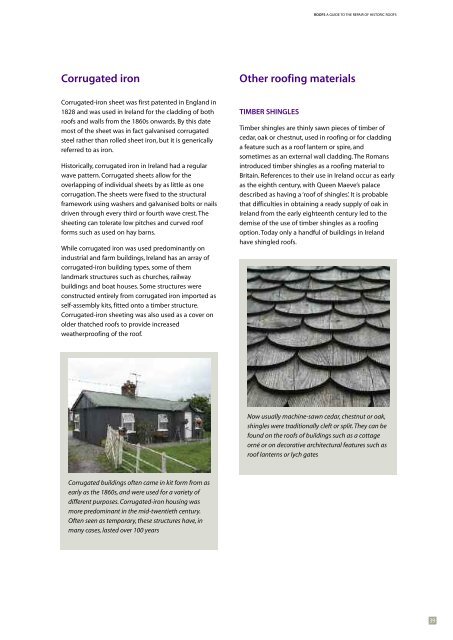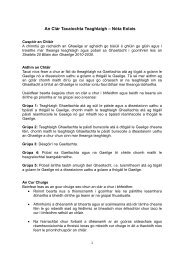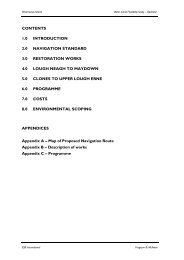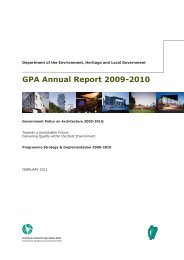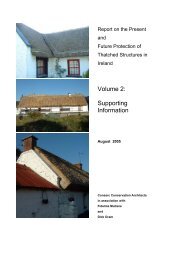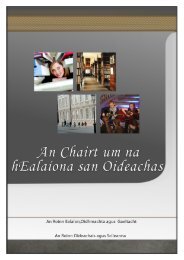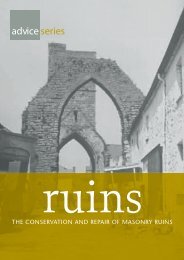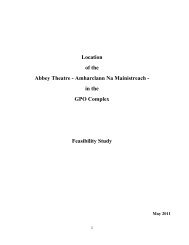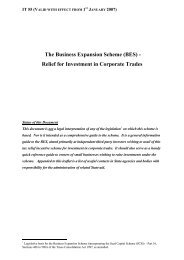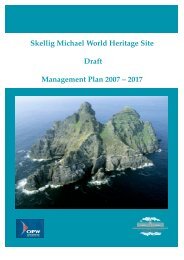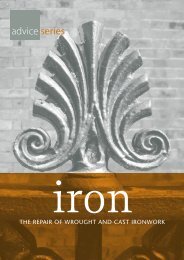A Guide to the Repair of Historic Roofs - Dublin City Council
A Guide to the Repair of Historic Roofs - Dublin City Council
A Guide to the Repair of Historic Roofs - Dublin City Council
Create successful ePaper yourself
Turn your PDF publications into a flip-book with our unique Google optimized e-Paper software.
ROOFS A GUIDE TO THE REPAIR OF HISTORIC ROOFSCorrugated ironO<strong>the</strong>r ro<strong>of</strong>ing materialsCorrugated-iron sheet was first patented in England in1828 and was used in Ireland for <strong>the</strong> cladding <strong>of</strong> bothro<strong>of</strong>s and walls from <strong>the</strong> 1860s onwards. By this datemost <strong>of</strong> <strong>the</strong> sheet was in fact galvanised corrugatedsteel ra<strong>the</strong>r than rolled sheet iron, but it is genericallyreferred <strong>to</strong> as iron.His<strong>to</strong>rically, corrugated iron in Ireland had a regularwave pattern. Corrugated sheets allow for <strong>the</strong>overlapping <strong>of</strong> individual sheets by as little as onecorrugation. The sheets were fixed <strong>to</strong> <strong>the</strong> structuralframework using washers and galvanised bolts or nailsdriven through every third or fourth wave crest. Thesheeting can <strong>to</strong>lerate low pitches and curved ro<strong>of</strong>forms such as used on hay barns.While corrugated iron was used predominantly onindustrial and farm buildings, Ireland has an array <strong>of</strong>corrugated-iron building types, some <strong>of</strong> <strong>the</strong>mlandmark structures such as churches, railwaybuildings and boat houses. Some structures wereconstructed entirely from corrugated iron imported asself-assembly kits, fitted on<strong>to</strong> a timber structure.Corrugated-iron sheeting was also used as a cover onolder thatched ro<strong>of</strong>s <strong>to</strong> provide increasedwea<strong>the</strong>rpro<strong>of</strong>ing <strong>of</strong> <strong>the</strong> ro<strong>of</strong>.TIMBER SHINGLESTimber shingles are thinly sawn pieces <strong>of</strong> timber <strong>of</strong>cedar, oak or chestnut, used in ro<strong>of</strong>ing or for claddinga feature such as a ro<strong>of</strong> lantern or spire, andsometimes as an external wall cladding. The Romansintroduced timber shingles as a ro<strong>of</strong>ing material <strong>to</strong>Britain. References <strong>to</strong> <strong>the</strong>ir use in Ireland occur as earlyas <strong>the</strong> eighth century, with Queen Maeve’s palacedescribed as having a ‘ro<strong>of</strong> <strong>of</strong> shingles’. It is probablethat difficulties in obtaining a ready supply <strong>of</strong> oak inIreland from <strong>the</strong> early eighteenth century led <strong>to</strong> <strong>the</strong>demise <strong>of</strong> <strong>the</strong> use <strong>of</strong> timber shingles as a ro<strong>of</strong>ingoption. Today only a handful <strong>of</strong> buildings in Irelandhave shingled ro<strong>of</strong>s.Now usually machine-sawn cedar, chestnut or oak,shingles were traditionally cleft or split. They can befound on <strong>the</strong> ro<strong>of</strong>s <strong>of</strong> buildings such as a cottageorné or on decorative architectural features such asro<strong>of</strong> lanterns or lych gatesCorrugated buildings <strong>of</strong>ten came in kit form from asearly as <strong>the</strong> 1860s, and were used for a variety <strong>of</strong>different purposes. Corrugated-iron housing wasmore predominant in <strong>the</strong> mid-twentieth century.Often seen as temporary, <strong>the</strong>se structures have, inmany cases, lasted over 100 years39


